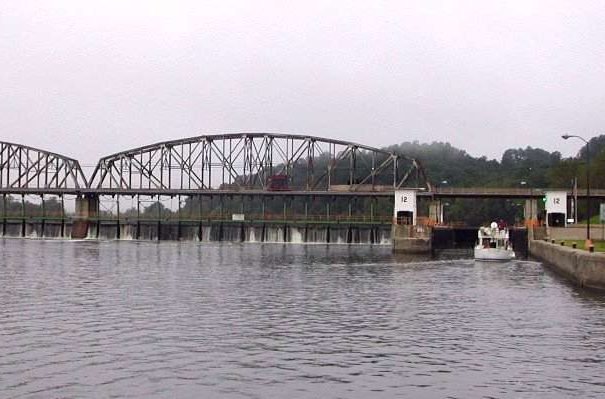
 At Schoharie Crossing State Historic Site you can see all three of the major phases of the Erie Canal – from the original “Clinton’s Ditch,” to the enlargements of the mid-19th century to the Barge Canal of today. You can also see Lock E-12 operated by the New York State Canal Corporation between Tribes Hill and Fort Hunter in Montgomery County, NY.
At Schoharie Crossing State Historic Site you can see all three of the major phases of the Erie Canal – from the original “Clinton’s Ditch,” to the enlargements of the mid-19th century to the Barge Canal of today. You can also see Lock E-12 operated by the New York State Canal Corporation between Tribes Hill and Fort Hunter in Montgomery County, NY.
This lock has a movable dam and is one of only two which also serve as an automobile bridge. It’s known as the “James Shanahan Lock.”
James Shanahan was born in Ireland in 1829 and came to New York at the age of eight, settling with his family in Onondaga County. When he was 15, they family moved to Ann Arbor, Michigan, although young James quickly returned to New York to work as a stone cutter with his brother.
They were contractors for the construction of Erie Canal Lock 50 (known as Gere’s Lock and located at the eastern edge of the Town of Camillus, Onondaga County) and locks 9 and 10 on the Oswego Canal (no longer operational).
Afterward he went to Lanesboro, Pennsylvania, where he was employed in the construction of the viaduct for the Erie Railroad. Returning to New York he and his brothers formed a contracting company which worked on the New York Central Railroad doing most of the masonry work on the bridges and viaducts between Rochester and Syracuse.
He was thereafter put in charge of masonry work on the Oswego and Syracuse Railroad, which began running in 1848, and in 1854 he was engaged as a contractor for the construction of locks on the Sault Ste. Marie Canal in Ontario.

 The next year he moved to Tribes Hill and worked on the construction of some locks in Waterford.
The next year he moved to Tribes Hill and worked on the construction of some locks in Waterford.
In 1859 he was employed by the Dorchester Freestone Company in the capacity of quarry overseer at the company’s quarries in New Brunswick. The company became very profitable under his supervision, in part through Shanahan’s connections in New York.
The company furnished stone “for some of the most extensive construction work being done then by the railroads in New York state, as well as for the great dam [1,400 feet long] at Cohoes and many other jobs of heavy masonry work.”
In 1868, Shanahan was appointed Superintendent of Section 3 of the Erie Canal which he remained until 1870, when he returned to being a contractor, using stone cut from his quarry at Tribes Hill. One of his first big jobs was construction of a New York Central Railroad bridge over the Hudson River at Albany (at the foot of Maiden Lane).
Other major projects included the masonry work associated with the Central Railroad double track line between Fort Plain and Fink’s Bridge (Little Falls) as well as one between Schenectady and Albany and also the viaduct at Broadway in Albany, built in 1882. Shanahan was also tasked with completing the stonework for that Railroad’s Schenectady Bridge.

 He had left his position as Erie Canal Superintendent because he was elected in 1869 to serve one term as a member of the New York State Assembly for Montgomery County.
He had left his position as Erie Canal Superintendent because he was elected in 1869 to serve one term as a member of the New York State Assembly for Montgomery County.
By 1878, his execution of projects and service in politics had grown his reputation in the region and he was appointed Assistant Superintendent of the recently created New York State Department of Public Works.
On February 13, 1883 Governor Grover Cleveland (Governor 1883-1885 and a two-term President after that) appointed him to Superintendent of that Department. He resigned from that position in 1889 during the governorship of David B. Hill (Governor 1885-1891; US Senator, 1891-1897).
(The office of Superintendent of Public Works was created by an 1876 amendment to the New York State Constitution. It abolished the canal commissioners and established that the Department of Public Works, responsible for most operations of the canal, including maintenance and navigation, excepting those reserved to the New York State Engineer and Surveyor who managed mapping, and developing plans and estimates for canal construction and improvement. Public Works was merged with other departments into the Department of Transportation in 1967)
In the later years of his Shanahan’s life he served as a contractor and consultant with several of the state’s railroad lines and canals. While most newspapers and contemporary accounts said Shanahan was not corrupt, at times complaints about him were voiced.
These were particularly in regards to competition between the canal system and the railroads and also his conflicting (although by then more minor) roles in county and state politics. He was prominent in the feuds between Cleveland (of the Bourbon Democracy) and Hill (a supporter of bimetallism), supporting the Cleveland faction which attracted the Republican Mugwumps.
James Shanahan sat on the boards of several corporations, including Shanahan, Briggs & Company of Fonda; Starin Silk Fabric Company of Fultonville; contractors Shanahan & Turner; a as a director in the Fultonville Bank.

 He also served as President of the Cayadutta Electric Railroad, an interurban local service between Fonda and Gloversville, and the Fonda, Johnstown and Gloversville Railroad, and very important rail line that connected Schenectady with the smaller communities to the west, and also northward as far as Northville and Sacandaga Park.
He also served as President of the Cayadutta Electric Railroad, an interurban local service between Fonda and Gloversville, and the Fonda, Johnstown and Gloversville Railroad, and very important rail line that connected Schenectady with the smaller communities to the west, and also northward as far as Northville and Sacandaga Park.
In 1875, along with several neighbors, he purchased the former Dutch Reformed Church building – “an unoccupied church, located on Main Streete [in Tribes Hill]… which was enlarged, remodeled, tastily finished and furnished” that was “presented to the bishop of the diocese.” This would become Sacred Heart Church which has since rebuilt.
James Shanahan died on March 12, 1896 in Albany, leaving a substantial estate. He had married Ellen Maloy of Ann Arbor, Michigan in 1854 and had eight children. One son, Edward J. Shanahan, served as a postmaster of Amsterdam, and also as President of Hygeia Ice Company there.
This essay first appeared on the website of Friends of Schoharie Crossing and in the Schoharie Crossing State Historic Site‘s newsletter.
John Warren contributed to this essay.
Illustrations, from above: Lock E-12 and adjacent dam and spillway on the Barge Canal; Home of James Shanahan in Tribes Hill; James Shanahane portrait; and a Cayadutta Electric Railroad Company stock certificate signed by James Shanahan.









Recent Comments